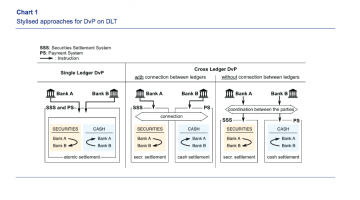
If there is an institution that can impact profoundly the economy of a country, it is that of Central Banks. Some of them, like the US Federal Reserve or the European Central Bank, have such an influence in the worldwide economy that they may prevent – or even start – a financial crisis. They are the last watchdog, reckoning whenever the economy is taking the wrong turn and trying to pull it back onto the right path.
Their mechanisms, though somehow limited and opaque for the wider public, are there to ensure private financial institutions comply with the national policy guidelines while their in-depth, exclusive research help governments to set out, precisely, the national economic policy. They are the only financial institutions allowed to control all the money reserves of a country and they need to deal with all sorts of external threats to keep the economy in track. Including, of course, lack of resources, capabilities and the overall instability of a globalized economy.
The problems central banks face are deep and complex, so most of them have embraced new technological advancements as a sort of balm for their challenges. That’s why, according to a report carried out by the World Economic Forum in 2019, approximately 40 central banks worldwide have laid their eyes upon a new technology that may well help them to meet their responsibilities: blockchain.
Blockchain is the latest buzzword in technology. It is an electronic distributed ledger – Distributed Ledger Technology (DLT) – that records all transactions made within it while it makes sure that all of them are genuine, safe and come from authorized partners. It can deal with massive amounts of data in a matter of seconds (nonetheless many describe it as a new-gen database) while its encryption capabilities are the top-notch of the known solutions in cybersecurity.
Moreover, blockchain can be programmed to allow “smart contracts” within the platform and even to “print” digital currencies as well. These two latter perks make the blockchain the perfect technology for financial institutions the size of central banks, to say the least.
Though blockchain is supposed to be decentralized and open to all participants, central banks and international institutions are more controlled platforms. For example, JP Morgan Chase launched a private version of the crypto network Ethereum, called Quorum, to support the fittingly-titled “JPM Coin.” And over the past year, technology powerhouse IBM has built an array of ‘decentralized’ ledgers for corporations with Stellar’s technology. These two examples come from the private spectrum, although a similar path has been taken by central banks worldwide.
This article reviews why financial institutions across the globe really want to, at least, experiment with the blockchain, especially in regions where submerged and uncontrolled economies are the commonplace.
Big Central Banks are also very interested in blockchain and cryptocurrencies. Blockchain has the potential to significantly disrupt the financial industry – which is something quite worrisome to the Central Banks if they are not involved and influencing the technology…If they can kill you, why not join them? Strategically, the potential threat of DLT to the existing financial industry must be turned into an opportunity by the central banks. Blockchain then, can provide the extra technological hand that most central banks worldwide need to function efficiently.
Pilots and Research: Central Banks’ First contact with blockchain
Experiments with blockchain solutions have been around since 2014, with some central banks from the West more interested in their capabilities and potential disruption of financial services. In that sense, some banks are more advanced in blockchain research than others. That is the case of banks such as Bank of Canada, the Bank of England, and the Monetary Authority of Singapore (MAS), who all have published some in-depth white papers exploring blockchain technology.
The Bank of England was one of the pioneers to explore blockchain as a future solution in a research paper published in 2014 and then in a broader report undertaken by the Government’s Office for Science in 2016. The European Central Bank (ECB) and the Bank of Japan are exploring the capabilities of this DLT. They conducted a joint pilot, Project Stella, beginning in 2016, which focuses on whether the technology can improve domestic interbank payments and settlements and facilitates rapid interbank trading and settlement of securities for cash.

Other banks experimenting with blockchain solutions are: the Central Bank of Brazil, which is exploring DLT for an interbank payments contingency and resiliency system (Project SALT) as well as a decentralized information exchange platform (Project PIER); the German central bank (Deutsche Bundesbank), which is exploring DLT for multiple purposes including for improving efficiency and reducing risk in interbank securities settlement processes with the BLOCKBASTER prototype and other efforts.
Also working on the same line of research is the Saudi Arabian Monetary Authority. This latter is conducting a joint experiment plan called Project Aber with the United Arab Emirates to pilot DLT for interbank payments and settlements between Saudi Arabia and the UAE.
A success story can be found in the case of a pilot implemented by the Bank of France which is functioning is the MADRE Project blockchain platform:
“The Bank of France, with project MADRE, has fully replaced its centralized process for the provisioning and sharing of SEPA Credit Identifiers (SCIs) with a decentralized, blockchain-based solution. According to a 2018 survey on the digital revolution in the French banking sector the project began as a proof-of-concept in June 2016 to learn more about DLT with a simple use case. The central bank identified an opportunity where DLT could be valuable to automate and digitize a manual and time-intensive process that requires coordination and information sharing with multiple banks,” noted the research.
Now, this alternative system decentralizes and automates the SCI management and sharing process with “smart contracts” or programmes within Ethereum and other blockchains that enable automatic transactions among participants using predetermined terms. Today, smart contracts are used to issue 100% of the SCIs in the system.
Central Banks and Blockchain – Part 2

Dinis Guarda is an author, academic, influencer, serial entrepreneur, and leader in 4IR, AI, Fintech, digital transformation, and Blockchain. Dinis has created various companies such as Ztudium tech platform; founder of global digital platform directory openbusinesscouncil.org; digital transformation platform to empower, guide and index cities citiesabc.com and fashion technology platform fashionabc.org. He is also the publisher of intelligenthq.com, hedgethink.com and tradersdna.com. He has been working with the likes of UN / UNITAR, UNESCO, European Space Agency, Davos WEF, Philips, Saxo Bank, Mastercard, Barclays, and governments all over the world.
With over two decades of experience in international business, C-level positions, and digital transformation, Dinis has worked with new tech, cryptocurrencies, driven ICOs, regulation, compliance, and legal international processes, and has created a bank, and been involved in the inception of some of the top 100 digital currencies.
He creates and helps build ventures focused on global growth, 360 digital strategies, sustainable innovation, Blockchain, Fintech, AI and new emerging business models such as ICOs / tokenomics.
Dinis is the founder/CEO of ztudium that manages blocksdna / lifesdna. These products and platforms offer multiple AI P2P, fintech, blockchain, search engine and PaaS solutions in consumer wellness healthcare and life style with a global team of experts and universities.
He is the founder of coinsdna a new swiss regulated, Swiss based, institutional grade token and cryptocurrencies blockchain exchange. He is founder of DragonBloc a blockchain, AI, Fintech fund and co-founder of Freedomee project.
Dinis is the author of various books. He has published different books such “4IR AI Blockchain Fintech IoT Reinventing a Nation”, “How Businesses and Governments can Prosper with Fintech, Blockchain and AI?”, also the bigger case study and book (400 pages) “Blockchain, AI and Crypto Economics – The Next Tsunami?” last the “Tokenomics and ICOs – How to be good at the new digital world of finance / Crypto” was launched in 2018.
Some of the companies Dinis created or has been involved have reached over 1 USD billions in valuation. Dinis has advised and was responsible for some top financial organisations, 100 cryptocurrencies worldwide and Fortune 500 companies.
Dinis is involved as a strategist, board member and advisor with the payments, lifestyle, blockchain reward community app Glance technologies, for whom he built the blockchain messaging / payment / loyalty software Blockimpact, the seminal Hyperloop Transportations project, Kora, and blockchain cybersecurity Privus.
He is listed in various global fintech, blockchain, AI, social media industry top lists as an influencer in position top 10/20 within 100 rankings: such as Top People In Blockchain | Cointelegraph https://top.cointelegraph.com/ and https://cryptoweekly.co/100/ .
Between 2014 and 2015 he was involved in creating a fabbanking.com a digital bank between Asia and Africa as Chief Commercial Officer and Marketing Officer responsible for all legal, tech and business development. Between 2009 and 2010 he was the founder of one of the world first fintech, social trading platforms tradingfloor.com for Saxo Bank.
He is a shareholder of the fintech social money transfer app Moneymailme and math edutech gamification children’s app Gozoa.
He has been a lecturer at Copenhagen Business School, Groupe INSEEC/Monaco University and other leading world universities.










